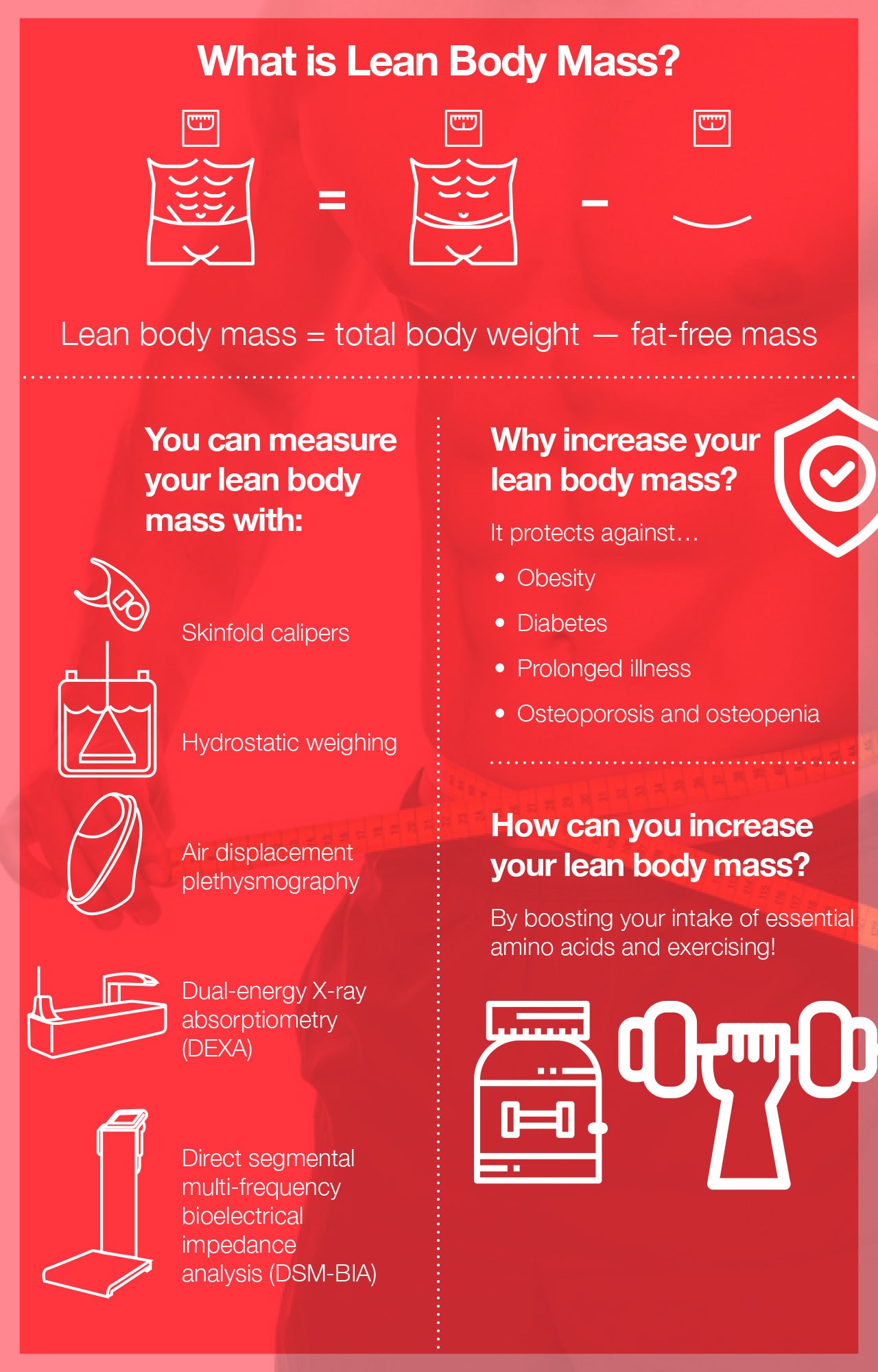How Amino Acids Increase Lean Body Mass
 By: by Amino Science
By: by Amino Science

Lean body mass declines with age due to sarcopenia, a condition characterized by the loss of lean tissue, muscle mass, strength, and function. Numerous studies show that taking an essential amino acid supplement can help increase lean body mass even in cases of insulin resistance when muscle-stimulating effects are subdued. In this article, we’re discussing the importance of lean body mass, how it differs from lean muscle mass, how to test your lean body mass, and how to build it up with amino acids.
What Is Lean Body Mass?
If you take your total body weight and subtract your fat mass you’ll have your lean body mass. In other words, your lean body mass is the mass of all your organs, including your bones, blood, skin, and muscles and excluding your body fat. On average, lean body mass makes up about 60-90% of total body weight, with men typically having a higher percentage of lean body mass than women.
Lean body mass, which is also called lean mass or fat-free mass, is often used interchangeably with the term lean muscle mass. It is not, however, the same thing.
Lean Body Mass vs. Lean Muscle Mass
The term lean muscle mass is actually a misnomer. Lean by definition means the absence of fat, so all muscle is by its sheer nature lean. Muscle mass is the size of your muscles, and lean body mass includes your muscle mass.
The major types of muscle include cardiac, smooth, and skeletal muscle, but skeletal muscle is the only kind that you can enlarge with nutrition and exercise. If you are looking to increase your lean body mass, then targeting the growth of your skeletal muscles is a key strategy.
You see, your organs can’t significantly change your lean body mass. Neither can your bone density, which declines with age but not enough to make a huge difference in your lean body mass. Changes in lean body mass are largely due to an increase in muscle mass and an increase in water.
How Water Affects Your Lean Body Mass
Lean body mass is made up of three components:
- Intracellular water (fluid within cells)
- Extracellular water (fluid surrounding cells)
- Dry lean mass (protein and bone mineral content)
As you can see, two parts of lean body mass are water, and muscle itself is made up of 79% water, so any quick and large gains in lean body mass are most likely due to water. For instance, if you drink enough water to increase your body weight by a pound, then you’re also gaining lean mass.
Resistance exercise likewise increases the concentration of intracellular water, which in turn increases lean mass. These aren’t, however, the lasting gains in muscle mass you’re probably after.
In order to monitor your lean body mass and make sure you’re achieving the desired muscle growth, you need the right tools.
Measuring Lean Body Mass
When it comes to tracking your lean body mass the scale won’t cut it. Changes in your body weight or your body mass index (BMI) aren’t accurate indicators of lean body mass. An increase, for instance, doesn’t mean you’ve bulked up with muscle mass. It might be an increase in fat, or water retention, or an undigested meal.
It takes a more sophisticated analysis of your body composition.
Skinfold Calipers
Although calipers aren’t the most accurate, as they work on the assumption that body fat is evenly distributed throughout the body, they are convenient and easy to use. Calipers measure skin folds at specific locations on the body, such as the triceps, quadriceps, and abdomen. Plug those measurements into a formula to get your body fat percentage, which can then be subtracted to find your lean body mass.
Hydrostatic Weighing
Also called underwater weighing, hydrostatic weighing measures your body density, and therefore your body fat and lean mass, using Archimedes principle of displacement, which states that the upward buoyant force on a fully or partially submerged object is equal to the weight of the fluid displaced. So, a person with more muscle mass will weigh more submerged under water than someone with more body fat who will be more buoyant.
Air Displacement Plethysmography
During air displacement plethysmography you will sit inside a chamber. The volume of air you displace is equal to your body volume. This is then used to determine the ratio of fat mass to lean mass as well as resting metabolic rate and total energy expenditure. It is believed to be as accurate as hydrostatic weighing but is a less involved testing method.
Dual-energy X-ray Absorptiometry (DEXA)
Considered the gold standard of body composition tests, DEXA uses two low-energy X-ray beams to calculate your bone density as well as your body fat percentage, lean body mass, and skeletal muscle mass. This 3-15 minute full-body scan is extremely useful for tracking changes in muscle and lean tissue overtime.
Direct Segmental Multi-frequency Bioelectrical Impedance Analysis (DSM-BIA)
DSM-BIA is BIA technology that measures the entire body, dividing it into five segments and determining the rate at which an electrical current travels through the body, or the impedance. Body fat has more resistance, or impedance, than does fat-free mass, for instance. With this information, a clear picture of body composition emerges, including fat mass vs. lean body mass and its precise makeup: extracellular water, intracellular water, and skeletal muscle mass. Research shows that DSM-BIA rivals DEXA in terms of lean body mass accuracy (1).

The Importance of Lean Body Mass
Lean body mass is like a protective suit of armor. It helps keep your metabolism running on all cylinders so that you can maintain a healthy weight, it lowers inflammation, and it increases your likelihood of survival and recovery from many chronic illnesses and acute injuries.
- Protects against obesity: Muscle burns more calories, even at rest, than fat does, so the more lean body mass you have, the more calories you burn, which shields against fat accumulation and potential obesity. Obesity can give rise to life-threatening chronic conditions, including heart disease and non-alcoholic fatty liver disease.
- Protects against insulin resistance and diabetes: One of the functions of muscle is to clear glucose from the blood and maintain healthy blood sugar levels. Higher muscle mass is linked to better insulin sensitivity, which lowers the risk of developing type 2 diabetes.
- Protects against prolonged illness: When we are sick or injured our bodies look to muscles to provide the necessary protein for recovery. The less muscle mass you have, the more difficult it is for your body to heal. For example, research indicates patients with lung cancer who had a decrease in lean body mass due to cancer therapy had a higher rate of recurrence and a greater likelihood of death than patients who maintained muscle mass (2).
- Protects your bones: The more substantial your muscle mass, the better your bones. One study showed that lower muscle mass was associated with weaker and thinner bones in elderly men. Research also indicates that lean body mass helps reduce your risk of fractures and falls.
Increase Lean Body Mass with Amino Acids
Muscle becomes increasingly important as we age. It helps keep amino acid and blood sugar levels stable, optimizes bone health, boosts longevity, and improves health outcomes in a number of medical conditions.
Amino acids build the muscles that keep us strong and healthy. We make some of these amino acids internally, but the essential amino acids we can only get from dietary sources. These essential amino acids are the key to increasing muscle strength, mass, and function.
If you want to gain lean body mass, then you want to make sure you’re getting enough essential amino acids in your diet. You’ll also want to start a resistance training program, as amino acids and strength training work synergistically to increase lean body mass.
The easiest way to ensure essential amino acid intake is with a supplement targeted to improve exercise performance and muscle mass. The appropriate supplement will have a higher ratio of leucine.
Research shows that a higher concentration of leucine to other essential amino acids is ideal because leucine plays an important role in muscle protein synthesis. Leucine triggers initiation factors that accelerate protein synthesis. This is particularly important for older adults who have a blunted response to these initiation factors.
If you are interested in increasing your lean body mass with amino acids, then click here to learn more about Life, Amino Co’s patent-pending essential amino acid formula designed to increase lean body mass while improving quality of life and longevity.

Up to 25% off Amino
Shop NowTAGS: fitness health lean body mass
Join the Community
Comments (0)
Most Craveable Recipes




 833-264-6620
833-264-6620



















